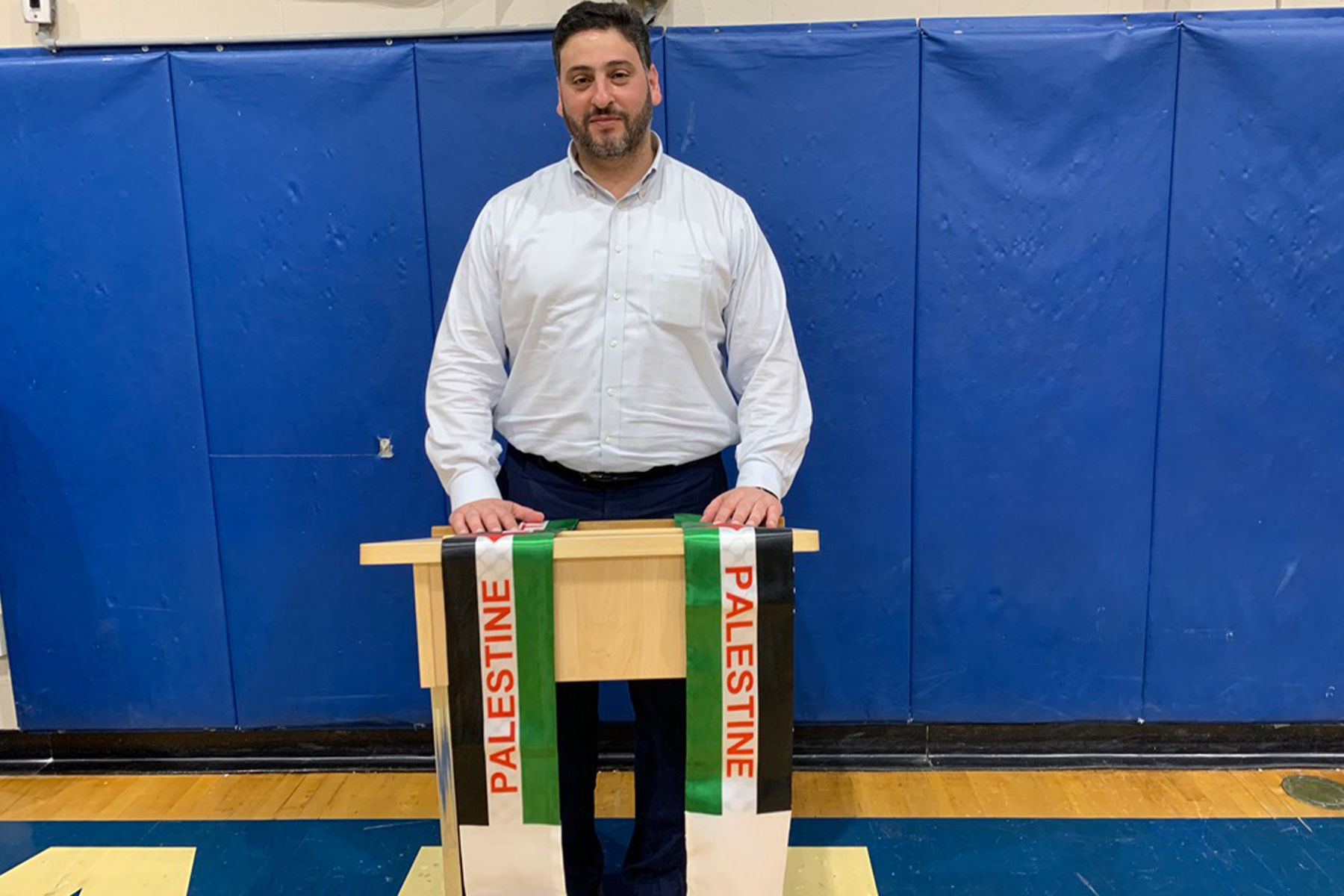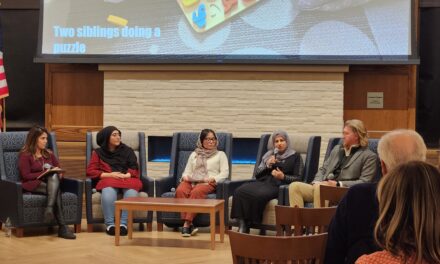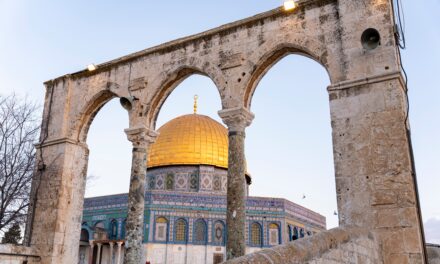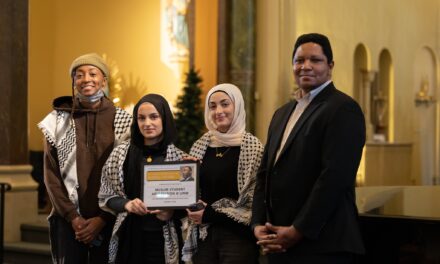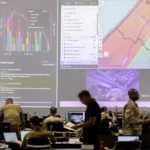“The Palestine issue has been about deception,” said Dr. Osama Abuirshaid, executive director of American Muslims for Palestine, in a lecture titled “No to the Theft of the Century: Understand the So-called Deal of the Century and Its Implications.”
Yet, he expressed hope in young Americans to eventually bring a just resolution for the Palestinians.
Abuirshaid is a regular commentator about Palestinian and Middle Eastern affairs, as well as American domestic and foreign policy, for various Arab satellite TV channels, such as Al Jazeera. He previously lived in Milwaukee and was an active member of the local Muslim community.
More than 150 people came to the Islamic Society of Milwaukee, 4707 S. 13th Street, Sunday, Feb. 16, to hear the details of the Trump administration’s Mideast peace plan, which the president has called “the deal of the century.”
“We are holding this event so our community understands what we call ‘the steal of the century,’ said Munjed Ahmad, AMP’s national vice chairman. “We want our community to understand it and to be able to respond to questions about it.”
A bi-lateral Mideast peace plan
On Jan. 28, flanked by Israeli Prime Minister Benjamin Netanyahu, President Trump unveiled a peace plan developed bi-laterally with Israel.
“When Trump announced the deal of the century, who is standing next to him?” Abuirshaid asked. “Where were the Palestinians? They weren’t even consulted or invited.
“Mahmoud Abbas calls it ‘the slap of the century.’ I would say it is the deception of the century,” said Abuirshaid. “As Palestinians, we are used to it. We have been lied to time and time again.
“There is nothing new about this plan other than the U.S. coming clean this time to say where it really stands. If anyone thinks this is exclusive to the Trump administration, that Trump just broke away from established U.S. policy, I will tell you that it is 70 years of the U.S. policy that got us to where we are today. Every administration that came, Democrat or Republican, paved the way.”
Abuirshaid’s list deceptions in the proposal
- “The official name of the plan is ‘Peace to Prosperity Vision to Improve the Lives of the Palestinian and the Israeli People.’ This is the first deception. If you read the 181 pages, the 22 sections, and the four appendices, you will find nothing about improving the lives of the Palestinian people.”
- “This is an Israeli plan: it is not an American plan,” Abuirshaid said. “It reflects the agenda of the extreme right-wing coalition that governs the state of Israel today. It does not reflect the entire political landscape in the state of Israel. The Trump administration is nothing more than a conduit.”
- “This is a regional plan,” he said. “It integrates Jordan, Egypt and Lebanon with the Palestinian Authority to solve the problem at their expense.”
The Saudis, Emiratis and Qateris have pledged to invest $50 billion over 10 years to Egypt, Jordan and Lebanon, but the funds will not cover the costs involved. And there is not a clear commitment from the U.S. to contribute, he said.
“Why single out Jordan, Egypt and Lebanon? Egypt will be expected to allow factories in Sinai, under the supervision of Israel, to contribute to the Palestinian economy, mainly in Gaza. And Egypt will be expected to allow the establishment of seaports in Sinai, under the supervision of Israel.
“Israel will continue to control the borders and crossings even within the proposed Palestinian state. So, Israel will tax the imports and exports, while also maintaining supervision over the security issues.
“Jordan will have to absorb and naturalize all the Palestinian refugees inside Jordan. Jordan is expected to give equal rights to Palestinians. But it is not because (the Trump and Netanyahu administrations) care about the Palestinians; it is because they want Jordan to become Palestine.
“Israel will provide technology and they will charge us for it. Israel will build the infrastructure and we will be charged for it. And we will buy electricity from Israel.”
- “This plan was implemented before it was announced,” he said. “Concrete steps were already endorsed on the ground and last month the official announcement was made. That’s all,” he said.
So, rather than negotiate peace, President Trump neutralized the issues of conflict in Israel’s favor, Abuirshaid noted. “In 2017, he announced the U.S. recognition of Jerusalem as Israel’s capital.
“And in May 2018, he relocated the embassy to Jerusalem.
“He did the same thing with the refugees,” Abuirshaid said. “In 2019, Trump defunded the United Nations Relief and Works Agency for Palestine Refugees. One of the justifications was that the existence of UNRWA perpetuates the Palestinian refugee problem. So, he just got rid of it.”
Under the plan, only Palestinians born prior to 1948 and who do not have citizenship elsewhere could potentially qualify to move to the new Palestinian state (which would not necessarily be where they were from). However, the future Palestinian state would have the burden of proving it has sufficient infrastructure and an economy strong enough to handle returning Palestinians, subject to Israeli approval.
Let me ask you a question. What is the root cause of the problems in Palestine we have today?” Abuirshaid asked.
“Occupation,” a woman in the audience called out.
“That’s right,” Abuirshaid agreed. “Occupation. You would imagine that 181 pages that deal with the Israeli-Palestinian conflict would mention the word occupation. It does not.”
“It talks about ‘captured lands’ in a defensive war – that Israel captured these lands in 1967 from invading Arab armies. Yet it is proven and documented that Israel started the war of 1967. In fact, the U.S. told the Israelis that the Egyptian army was in a defensive position and urged them not to “initiate hostilities.”
“This new document rewrites history,” he said.
Impositions on the Palestinians
The plan includes the annexation of all West Bank settlements to Israel, along with most of the Jordan Valley.
“We have to recognize Israel as a Jewish state,” Abuirshaid said. “A Jewish state means it is exclusive for Jews. Only Jews have rights in a Jewish state.
“We have to accept Israel’s right to conduct military operations inside the proposed Palestinian state.
“In addition, as part of ending incitement, no Palestinian can talk about any rights in historical Palestinian. No Palestinian can talk about Akka or Haifa. This will be considered incitement.
What the proposal offers Palestinians
The plan “creates a pathway” for a Palestinian state after four years rather than immediate recognition of one, Abuirshaid said. And that state, if approved, will have limited sovereignty, subject to Israeli security concerns.
“This state has to be disarmed. This state is non-contiguous but it is connected. Connected by what? In Abbas’ speech before the U.N. Security Council, he referred to it as Swiss cheese. It is connected by bridges and tunnels that are under Israel’s control. And the connections are not only between the West Bank and Gaza. Within the West Bank itself, non-contiguous enclaves are part of the proposed Palestinian state.
Once Israel has confirmed we have met these conditions, then the negotiations for a Palestinian state will take place.
“The 22% of historical Palestine that is today the West Bank and Gaza is less than 2,300 square miles. What the Trump administration’s plan offers is less than 40% of that area,” Abuirshaid said. “And we will not control the borders,” he added.
“Israel will annex 87% of the territory it controls today, including 60% of the West Bank and the Jordan Valley.
“Ninety-seven percent of the Palestinians in the West Bank will live in a Palestinian state. The remaining 3% will live in enclaves in Israel’s territory.”
And although the plan states there should be no forced population transfers that would lead to civil unrest, there are 350,000 Palestinians who are Israeli citizens who live in land that the proposal gives to Israel, Abuirshaid explained. “They will be transferred to the Palestinian state so that Israel will maintain its Jewishness and the Palestinians who have Israeli citizenship, Muslims and Christians, who constitute about 20% of the current citizens of the state of Israel, will be reduced to about 13% or 14%.”
And what about Jerusalem? he asked. “Under the plan, the Palestinians and Israelis share Jerusalem. But what Jerusalem? The Palestinian capital, called El Kuds in the plan rather than Jerusalem, will be created to the north and east of the security wall.
“And while Jordan will maintain special rule over the religious sites inside Jerusalem, the city will remain under Israeli sovereignty, subject to approval of the Israelis, not the Palestinians.”
The proposed Palestinian state will be cut off from the borders with Jordan. Gaza’s borders will be under Israeli and Egyptian control, who will negotiate without the Palestinians. Gaza’s coast will be subject to the Israeli Coast Guard. Any future seaports or airports in Palestinian land will be under Israeli supervision.
“So, Palestinians are cut off, with no borders, no security and no right to control the security of the air space. It will have no right to enter into any military agreements with any state or share any intelligence without the approval of Israel.”
Hope for the future
While the immediate future looks grim, Abuirshaid said he finds hope in the political views of millennials. He noted that the Progressive Movement in the Democratic Party has growing sympathy for the Palestinians. Likewise, “those born after 1983 are more sympathetic to the Palestinian cause.
Abuirshaid likened the rising sentiment for the Palestinians to the issue of stricter gun laws. Although most Americans support new laws to address the epidemic of mass shootings, the Obama administration failed to push the legislation forward during its eight years. Why? “The 76% who favor stricter gun laws were less passionate than those who were against them,” he said.
“If we start holding our elected officials accountable, then we can build a bridge between the new sentiments that are taking root in society and translate them into policies. It may take 10 years until we get to that point, but we can see the change that is taking place now.”
The AMP, which was initiated in Milwaukee in 2006, aims to build that bridge, Abuirshaid said. “We realize we have a solid community of eight million Muslims who stand behind us and so many supporters in the American society, like Jewish Voice for Peace and others who see Palestine as a social just issue.”
He called on the American Muslim community to be more engaged in supporting the Palestinians by participating in Palestine Advocacy Day, March 22-24. “This year we promise to bring 750-1,000 from across the country to walk down the halls of Congress. Let’s send a powerful message to our elected officials that there is a constituency that cares about Palestine.”
He also called for sending 20 delegates to the Democratic National Convention for the cost of $10,000 ($500 per delegate).
“Want to defeat oppression in Palestine and defeat the Trump-Netanyahu plan? This is the way,” he said.
Dr. Abuirshaid’s lecture was sponsored by the AMP, the Milwaukee Muslim Women’s Coalition, the Muslim American Society Milwaukee, and MA’RUF.
In addition to his speech, a parade of Muslims from various countries spoke about Palestine being an issue of concern for all Muslims. Othman Atta of the Islamic Society of Milwaukee provided context for the lecture with an overview of the modern history of Palestine. A summary of the history is available on the AMP website.
